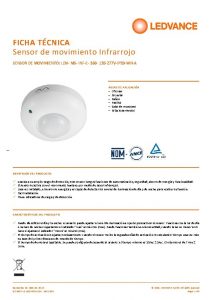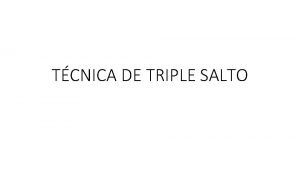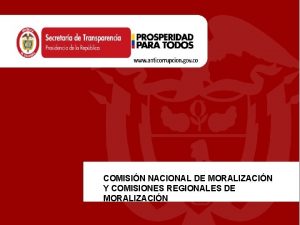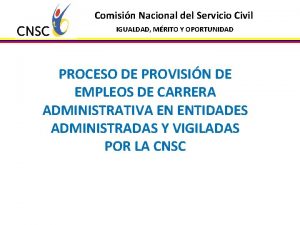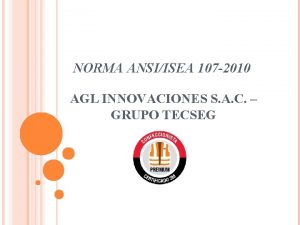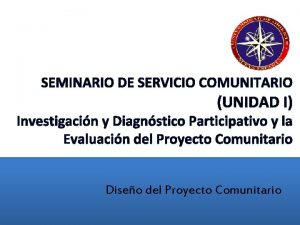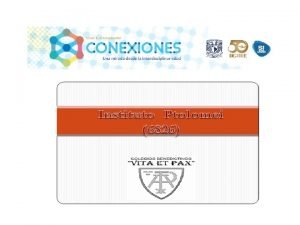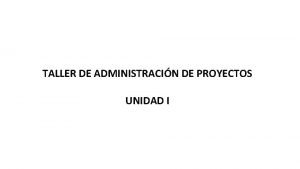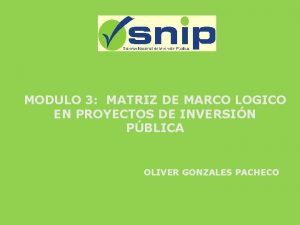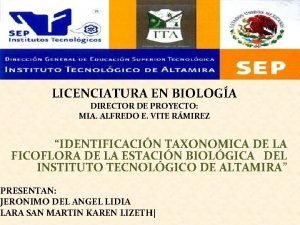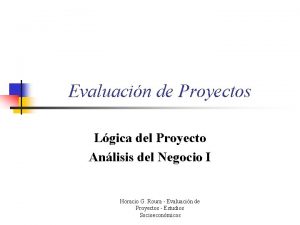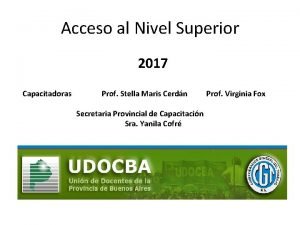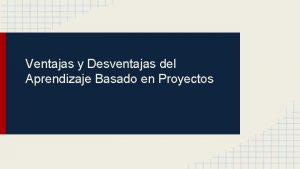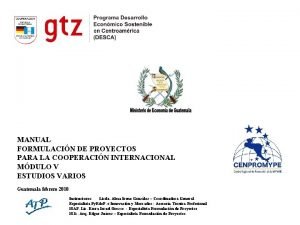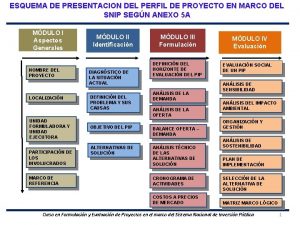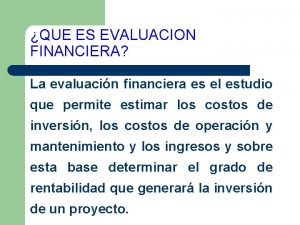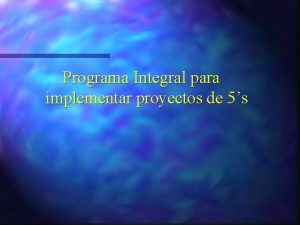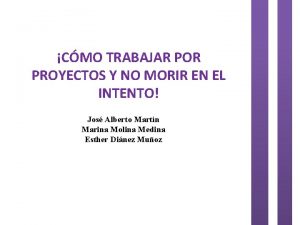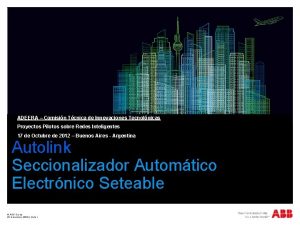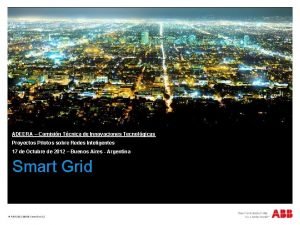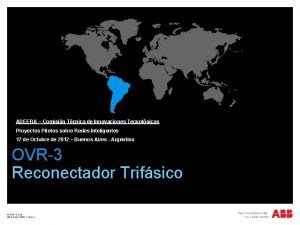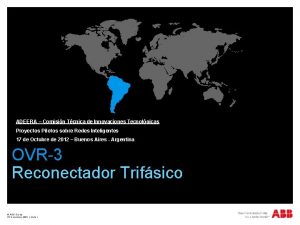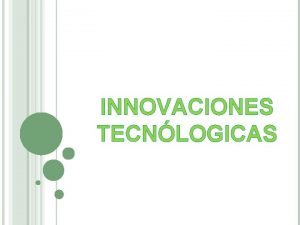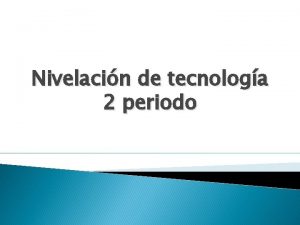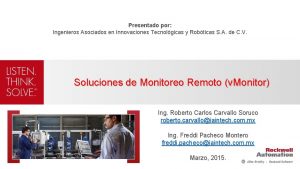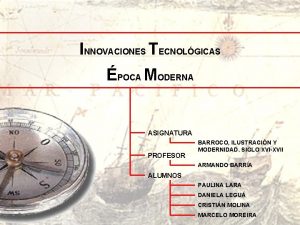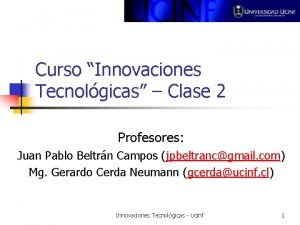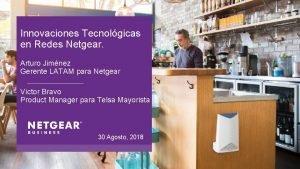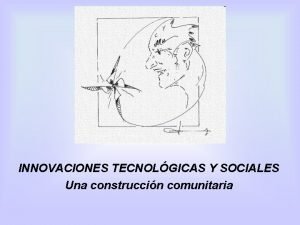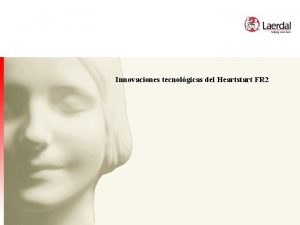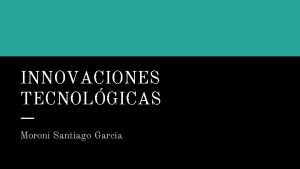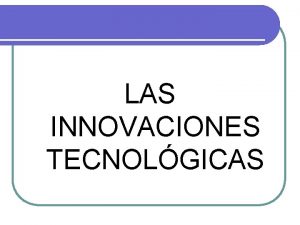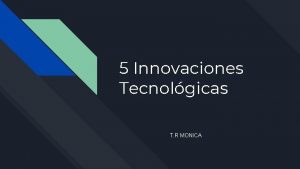ADEERA Comisin Tcnica de Innovaciones Tecnolgicas Proyectos Pilotos






































































- Slides: 70

ADEERA – Comisión Técnica de Innovaciones Tecnológicas Proyectos Pilotos sobre Redes Inteligentes 17 de Octubre de 2012 – Buenos Aires - Argentina Smart Grid © ABB 2012 -09 -06 Smart. Grid | 2

Smart Grid - Concept A Smart Grid is an electrical grid that gathers, distributes, and acts on information about the behavior of all components in order to improve the efficiency, reliability, economics, and sustainability of electricity services. Smart Grid – Priorities based on Customer Value Drivers - Increased Capacity – increase power delivery using existing infrastructure - Improved Reliability – reduce number and duration of outages, increase asset life - Greater Efficiency – improve power factor, perform voltage management, provide bidirectional power flow - Sustainability – solutions for distributed generation as well as increased usable life of assets through performance monitoring and analytics - Interoperability and Integration of New Technologies: Storage, Wireless communications, FDIR, VVM, Monitoring/Diagnostics § Smart Grid is the future evolution of the entire power network. § Smart Grid includes both transmission and distribution, focuses on the integration of renewable generation, reliability and efficiency of the grid. © ABB 2012 -09 -06 Smart. Grid | 2

Smart Grid – Challenges of the grid The objective of the electricity service is to provide consumers with safe, reliable electricity on demand. Consumers should be free to use electricity whenever they like. It must be the grid that accommodates the consumer. Smart Grid Network Challenges © ABB 2012 -09 -06 Smart. Grid | 2

Smart Grid – Network Challenges – Faults in the System Faults occurs because of overloading, overvoltage, under frequency, power swings. It is not practical to design and build electrical networks so as to completely eliminate the possibility of failure in operation. Smart Grid – Network Challenges – Cost of Power Interruptions Total Loss due to Power Interruptions Industrial 72% Commercial 25% Residential 3% © ABB 2012 -09 -06 Smart. Grid | 2

Self Healing Grid Strategies Challenges facing utilities today § The industry is moving toward a deregulated, competitive environment requiring accurate information about system performance § CAIDI (Customer Average Interruption Duration Index) and SAIDI (System Average Interruption Duration Index) scores are under close scrutiny § Limited capital budgets for continued improvements in grid reliability © ABB 2012 -09 -06 Smart. Grid | 2

Self Healing Grid Strategies Improvement Goals § Implementing Self Healing or Fault Detection Isolation and Restoration (FDIR) can help utilities: § Improve CAIDI and SAIDI metrics by up to 33% § Decrease restoration time to less than 30 seconds § Reduce the cost of restoration § Prevent lost revenues § Boost the utility’s reputation with customers, stockholders and regulators © ABB 2012 -09 -06 Smart. Grid | 2

Self Healing Grid Strategies 1 st business model: Device level or peer-to-peer § Device level and/or peer-to-peer § § A group of reclosers, load break switches, and feeder circuit breakers operate together to restore power in the most optimal manner Benefits § Allows utilities to focus investments on feeders that experience the most outages § Fast implementation § Initial low capital investment § Target solution appropriate for problem feeders § Improves SAIDI and CAIDI scores © ABB 2012 -09 -06 Smart. Grid | 2

OVR and Grid. Shield Recloser General overview MV outdoor products for smart grid demands - 15/27/38 k. V, 110 -170 k. V BIL, 800/1000 A Cont. , 12. 5 and 16 k. A Interrupting - Operate as recloser, sectionalizer, automated load break switch - Capable of three- and single-phase operation - High voltage cabinet Modular pole design Embedded voltage sensing Electronic free © ABB 2012 -09 -06 Smart. Grid | 2

Autolink Sectionalizer General overview MV outdoor products for smart grid demands - 15/27/33 k. V 6 -215 A settable acutating current Electronic Sectionalizer Three-phase tripping Single-phase tripping Replaces fuses, increases coordination Detects symmetric and asymmetric inrush currents © ABB 2012 -09 -06 Smart. Grid | 2

Device level Loop automation (no communications) Midpoint Recloser Sectionalizing Recloser Substation Circuit Breaker Source 1 52 52 Grid. Shield 3 VT’s 1 VT Tie Point Recloser Sectionalizing Recloser Substation Circuit Breaker Source 2 1 VT Midpoint Recloser 52 52 Grid. Shield 1 VT 52 Grid. Shield 3 VT’s

Device level Loop automation (no communications) Sectionalizing Recloser Substation Circuit Breaker Source 1 52 Grid. Shield Midpoint Recloser Fault 52 X Grid. Shield 3 VT’s 1 VT Tie Point Recloser Sectionalizing Recloser Substation Circuit Breaker Source 2 1 VT Midpoint Recloser 52 52 Grid. Shield 1 VT 52 Grid. Shield 3 VT’s

Device level Loop automation (no communications) Sectionalizing Recloser Substation Circuit Breaker Source 1 52 Grid. Shield Midpoint Recloser Fault 52 X Grid. Shield 3 VT’s 1 VT Tie Point Recloser Sectionalizing Recloser Substation Circuit Breaker Source 2 1 VT Midpoint Recloser 52 52 Grid. Shield 1 VT 52 Grid. Shield 3 VT’s

Device level Loop automation (no communications) Sectionalizing Recloser Substation Circuit Breaker Source 1 52 Grid. Shield Midpoint Recloser Fault 52 X Grid. Shield 3 VT’s 1 VT Tie Point Recloser Sectionalizing Recloser Substation Circuit Breaker Source 2 1 VT Midpoint Recloser 52 52 Grid. Shield 1 VT 52 Grid. Shield 3 VT’s

Device level Loop automation (no communications) Sectionalizing Recloser Substation Circuit Breaker Source 1 52 Grid. Shield Midpoint Recloser Fault 52 X Grid. Shield 3 VT’s 1 VT Tie Point Recloser Sectionalizing Recloser Substation Circuit Breaker Source 2 1 VT Midpoint Recloser 52 52 Grid. Shield 1 VT 52 Grid. Shield 3 VT’s

Device level Loop automation (no communications) Sectionalizing Recloser Substation Circuit Breaker Source 1 52 Grid. Shield Midpoint Recloser Fault 52 X Grid. Shield 3 VT’s 1 VT Tie Point Recloser Sectionalizing Recloser Substation Circuit Breaker Source 2 1 VT Midpoint Recloser 52 52 Grid. Shield 1 VT 52 Grid. Shield 3 VT’s

Device level Peer-to-Peer (requires communications) Sectionalizing Recloser Substation Circuit Breaker Source 1 Midpoint Recloser 52 52 Grid. Shield Tie Point Recloser IEC 61850 Communications Substation Circuit Breaker Source 2 Sectionalizing Recloser Midpoint Recloser 52 52 Grid. Shield

Device level Peer-to-Peer (requires communications) Sectionalizing Recloser Substation Circuit Breaker Source 1 52 Grid. Shield Midpoint Recloser Fault X 52 Grid. Shield Tie Point Recloser IEC 61850 Communications Substation Circuit Breaker Source 2 Sectionalizing Recloser Midpoint Recloser 52 52 Grid. Shield

Device level Peer-to-Peer (requires communications) Sectionalizing Recloser Substation Circuit Breaker Source 1 52 Grid. Shield Midpoint Recloser Fault X 52 Grid. Shield Tie Point Recloser IEC 61850 Communications Substation Circuit Breaker Source 2 Sectionalizing Recloser Midpoint Recloser 52 52 Grid. Shield

Device level Peer-to-peer (requires communications) Sectionalizing Recloser Substation Circuit Breaker Source 1 52 Grid. Shield Midpoint Recloser Fault X 52 Grid. Shield Tie Point Recloser IEC 61850 Communications Substation Circuit Breaker Source 2 Sectionalizing Recloser Midpoint Recloser 52 52 Grid. Shield

Summary device level § Initial low capital investment § Target solution appropriate for problem feeders § Improves SAIDI and CAIDI scores § Loop schemes requires voltage sensors § Peer-to-peer requires high speed communications – IEC 61850 is only standards based peer-to-peer solution available § Protection/coordination engineers manage logic © ABB 2012 -09 -06 Smart. Grid | 2

Self Healing Grid Strategies 2 nd business model: Substation level § Coordinated control between groups of reclosers, load break switches, and substation circuit breakers within a substation and possibly with adjacent substations § IEDs monitor and control switches § Substation computer collects data from IEDs § FDIR active logic resides on substation computer § Automatic identification and isolation of a fault § Automatic power restoration § Generally faster response than control centerbased FDIR © ABB 2012 -09 -06 Smart. Grid | 2

Substation level Substation based supervision Sectionalizing Recloser Substation Circuit Breaker Source 1 52 Fault X Grid. Shield Midpoint Recloser 52 Grid. Shield Tie Point Recloser DNP Communications Substation Circuit Breaker Source 2 Sectionalizing Recloser Midpoint Recloser 52 52 Grid. Shield

Substation level Substation based supervision

Substation level Substation computer-based FDIR active logic © ABB 2012 -09 -06 Smart. Grid | 2

Summary Substation Level § Initial low capital investment § Target solution appropriate for problem feeders § Can provide multiple paths for restoration, but generally best fit if all sources for restoration are from same substation § Improves SAIDI and CAIDI scores § Requires communications (lower baud, i. e. , 9600) but possibly already in place § Protection/coordination engineers must work with SCADA engineers. § Should reduce customized logic in protection devices § Utilities realize benefits on groups of substations and the feeders they control © ABB 2012 -09 -06 Smart. Grid | 2

Self Healing Grid Strategies 3 rd business model – Centralized control © ABB 2012 -09 -06 Smart. Grid | 2 § IEDs monitor and control switches § Substation computer collects IED data § Substation computer acts as gateway – serves IED data to control center SCADA and DMS § Restoration Switching Analysis (RSA) run on DMS § Load flow analysis as part of RSA, i. e. , full network model used § Automated or advisory FDIR § Generally slower response than substation-based FDIR, but more comprehensive solution § Maximum improvement in SAIDI and CAIDI scores

Centralized control Source 2 Source 4 52 52 52 Grid. Shield 52 52 ( Grid. Shield Source 3 52 52 Source 1 52 Grid. Shield Fault 52 52 Grid. Shield X Grid. Shield 52 52 52 Grid. Shield Source 4 52 52 Grid. Shield B 52 Grid. Shield 52

Centralized control

Summary centralized control level § Requires SCADA applications, generally DMS with load flow and short circuit capability § Target solution appropriate for all feeders § Can provide multiple paths for restoration from multiple substations § Improves SAIDI and CAIDI scores § Requires communications (lower baud, i. e. , 9600) but possibly already in place. § Protection/coordination engineers must work with SCADA engineers § Should reduce customized logic in protection devices § Utilities realize benefits on groups of substations and the feeders they control © ABB 2012 -09 -06 Smart. Grid | 2

Aumento de confiabilidad en sistemas de distribución Reconectadores y Seccionalizadores Pérdida de ingreso por la noventa de energía. Penalizaciones. Incremento de gastos debido a reparación y mantenimiento. Costos por pérdidas sufridas por la industria / clientes residenciales. Pérdida de confianza de los consumidores. CALIDAD DE SERVICIO Automatización mediante equipamiento de RECONEXIÓN Cantidad y duración de interrupciones Control remoto Comunicación © ABB Group 24 November 2020 | Slide 30

Equipamiento de reconexión Solución adoptada © ABB Group 24 November 2020 | Slide 31 § Los fusibles son la primera etapa de protección pues protegen los transformadores de distribución en el extremo del alimentador de media tensión. § Luego, algunos fusibles se agrupan y aguas arriba se dispone un seccionalizador. El seccionalizador debe estar ajustado para coordinar con el fusible (corriente y conteos), y constituye la segunda etapa de protección. § Como elemento de corte, para posibilitar la operación del seccionalizador, se disponen los reconectadores. Los reconectadores deben estar coordinados con el ajuste de los seccionalizadores que se encuentren aguas abajo, con un intento más de reconexión. § En general, algunos reconectadores (de poste o subestación) se coordinan con un interruptor en SE.

Alimentador A Ejemplo de aplicación Ramal 1 Datos: S Cantidad clientes totales: 288 Potencia total: 576 k. VA Consumo promedio por cliente: 2 k. VA Cantidad de fallas: 10 fallas/km. año Longitud alimentador A: 5 km Ramal 2 13, 2 k. V 576 k. VA Hipótesis: Fallas homogéneamente distribuidas en los cinco ramales. Fallas temporales/totales: 80 %. Tiempo de reposición del servicio promedio: 3 hs. Difícil coordinación con elementos de protección de sobrecorriente, niveles de cortocircuito muy similares. Transformadores monofásicos: 25 k. VA Transformadores trifásicos: 63 k. VA © ABB Group 24 November 2020 | Slide 32 S R S S S Ramal 3 Ramal 5 Ramal 4

Índices de calidad de servicio Internacionales y locales Índices orientados al consumidor Internacionales (IEEE 1366) SAIFI: System average interruption frequency index SAIDI: System average interruption duration index © ABB Group 24 November 2020 | Slide 33 Índices orientados a la carga Locales (IRAM) FMIK: Frecuencia media de interrupción por k. VA nominal instalado TTIK: Tiempo total de interrupción por k. VA nominal instalado

Alimentador A Escenario 1: Caso base Ramal 1 Escenario 1: Consideraciones: No se dispone de equipamiento de reconexión. La totalidad de las fallas (temporales y permanentes) son despejadas por los fusibles en cada ramal. Las fallas están homogéneamente distribuidas en los ramales. 10 f / km. año x 5 km = 50 f / año 50 f/año / 5 r = 10 f / r. año Cl / r prom = 38 clientes / ramal Cl fuera de serv / r. año = 375 Ramal 2 Ramal 3 Ramal 5 Ramal 4 SAIFI: 6, 51 int/cl. año SAIDI: 19, 53 hs/cl. año © ABB Group 24 November 2020 | Slide 34

Alimentador A Escenario 2: Reconectadores Ramal 1 Escenario 2: Consideraciones: Equipamiento de reconexión, solamente reconectadores. El 80% de las fallas son temporales. El 40% de las fallas temporales son despejadas con el primer intento de recierre (fuse saving), no dejando ramales fuera de servicio. Las fallas están homogéneamente distribuidas en los ramales. 50 f / año (1 – 0, 4 x 0, 8) = 34 f / año 34 f/año / 5 r = 7 f / r. año Cl / r prom = 38 clientes / ramal Cl fuera de serv / r. año = 255 Ramal 2 R Ramal 3 Ramal 5 Ramal 4 SAIFI: 4, 43 int/cl. año SAIDI: 13, 28 hs/cl. año © ABB Group 24 November 2020 | Slide 35

Alimentador A Escenario 3: Reconectadores + Seccionalizadores Ramal 1 Escenario 3: Consideraciones: Equipamiento de reconexión: reconectadores y seccionalizadores. El 80% de las fallas son temporales. El 98% de las fallas temporales no dejan ramales fuera de servicio, por coordinación del seccionalizador con el reconectador. Las fallas están homogéneamente distribuidas en los ramales. 50 f / año (1 – 0, 1 x 0, 8) = 14 f / año 14 f/año / 5 r = 3 f / r. año Cl / r prom = 38 clientes / ramal Cl fuera de serv / r. año = 105 S Ramal 2 R S S Ramal 3 Ramal 5 Ramal 4 SAIFI: 1, 42 int/cl. año SAIDI: 4, 22 hs/cl. año © ABB Group 24 November 2020 | Slide 36 S

Resultados Mejora de confiabilidad NOTA: Ahorro aproximado entre el Caso Base y el Escenario 3 de 4500 a 5000 USD por año. Depende de los valores locales y de los costos y tiempo asociados a la reposición del servicio. No están consideradas penalizaciones por cortes de servicio. © ABB Group 24 November 2020 | Slide 37 Escenario 1 2 3 Caso base Reconectadores + Seccionalizadores Descripción N° de fallas reales El 98% de las fallas Todas las fallas son temporales se despejadas por los El 40% de las fallas eliminan por medio de fusibles que protegen temporales se intentos de recierre y el ramal, dejando eliminan en el primer coordinación entre siempre un ramal intento de reconexión. seccionalizadores y fuera de servicio. reconectadores. 50 34 14 SAIFI SAIDI 6, 51 19, 53 4, 43 13, 28 1, 41 4, 22 Mejora de confiabilidad Caso base 1: Escenario 2: Escenario 3: - 32% 78% / año

Ejemplo de operación Falla Temporaria ---- 2 fast curves ---- 2 slow curves Minimum melting time ABBGroup ©©ABB 24 November 2020| |Slide 38 38 24

Ejemplo de operación Falla Temporaria ABBGroup ©©ABB 24 November 2020| |Slide 39 39 24

Ejemplo de operación Falla Temporaria ABBGroup ©©ABB 24 November 2020| |Slide 40 40 24

Ejemplo de operación Falla Temporaria Comienzo de fusión de fusible ABBGroup ©©ABB 24 November 2020| |Slide 41 41 24

Ejemplo de operación Falla Temporaria ABBGroup ©©ABB 24 November 2020| |Slide 42 42 24

Ejemplo de operación Falla Temporaria ABBGroup ©©ABB 24 November 2020| |Slide 43 43 24

Ejemplo de operación Falla Temporaria Fusión irreversible ABBGroup ©©ABB 24 November 2020| |Slide 44 44 24

Aumento de Ganancias con Auto. Link Ingresos adicionales País: Argentina Moneda: USD Información de la red Carga por barrio: 104 k. W Fallas por año: 36 Fallas temporales: 80% ; Fallas permanentes: 20% Tiempo de corte de energía debido a una falla: 3 horas Precio de energía: 0, 041 USD/k. Wh Descripción Precio de la energía no vendida con Cutout Precio de la energía no vendida con Auto. Link Ingresos adicionales con Auto. Link © ABB Group 24 November 2020 | Slide 45 Fórmula Valor 0, 041 USD/k. Wh * 104 k. W * 36 * 3 h $ 461 0, 041 USD/k. Wh * 104 k. W * 36 * 0, 2 * 3 h $ 92 $ 369

Aumento de Ganancias con Auto. Link Ahorro de Costos País: Argentina Moneda: USD Información Fallas por año: 36 Fallas temporales: 80% ; Fallas permanentes: 20% Costo de cuadrilla: USD 20 Costo de fusible: USD 3 Descripción Costo Operativo y reemplazo de fusible con Cutout Costo Operativo con Auto. Link Ahorro de costos con Auto. Link © ABB Group 24 November 2020 | Slide 46 Fórmula Costo ($20 + $ 3) * 36 $ 828 $ 20 * 36 * 0, 2 $ 144 $ 684

Summary § Electric System performance and reliability are continually being scrutinized by customers and regulators § Performance indices are becoming more difficult to meet § Bottom line is that utilities need flexible and adaptable solutions to reduce outage restoration times § No single solution meets every customer’s needs § Device level solutions are generally “low cost”, easy to pilot and can be implemented by protection and control group § Substation level solutions provide multi-feeder restoration paths, again are easy to pilot and can re-use existing equipment and communications infrastructure § Centralized solutions offers most flexible and comprehensive restoration options. ABB – Complete Solution Provider Primary equipment for distribution systems Reclosers, 3 phase load break switches, single phase electronic recloser, single phase sectionalizers, cut outs, switches, instrument transformers, sensors Field devices (IEDs) Complete family of relays for transmision and distribution usage. Communication enabling devices (radio, satellite, fiber. . ) Substation gateway/HMI with automatic fault isolation and restoration © ABB 2012 -09 -06 Smart. Grid | 2

§ Tropos mesh network overview Wireless IP networks for mission-critical applications § High capacity, low latency, reliable, secure, adaptable § Mesh routers, directional radios, management § Installed for 8+ years § 850+ customers in 50+ countries § 60, 000+ installed routers § Utilities, public safety, mining, oil and gas, industrial, military

Tropos distribution/field area networks § Bridge gap between core network and field apparatus ABB Tropos Partners

Higher levels require more aggregate bandwidth § Same as enterprise networks

Challenges - Selecting a network comm. strategy § Selecting the right network technology to avoid stranded assets § AMI network solutions deliver sufficient capacity for meter reading – but can’t support network requirements for other smart grid applications § Some utilities select an AMI network solution without considering future application and network needs § Cyber security threats are real and will continue to evolve over time Traditional approach § Network per project § Strategic approach § Layered communications architecture § Supports for current plus future smart grid apps § Minimizes incremental spend for additional field applications Build/pay as you go § SCADA § AMI § Distribution Automation § Field data applications, …

TROPOS Keys to successful smarter grid networks § Standards-based - TCP/IP, 802. 11, 802. 3 Ethernet, 802. 1 x…. § High bandwidth & low latency - >10 Mbps throughput at e/node, <1 ms latency/hop § Resilient - Self organizing mesh, > 99. 99% to > 99. 999% system availability - Self-optimizing - Multiple communication paths, frequency channels and bands - Dynamic routing, power control and data rate control § Tough - Industrial strength shock and vibration certified - Proven to withstand extreme heat, cold, wind, rain, snow, ice and humidity, including hurricanes - Telecom class electrical protection, approved for use in electric utility substations § Secure - Multi-layer/multi-application model and standards compliant - Integrated firewall and VPN - AES encryption - U. S. government certified security § Manageable § Scalable to cover small areas to thousands of square miles

How the Tropos mesh works Tropos mesh software leverages redundant paths, channels, frequencies, and backhaul locations to create the most robust network possible

Tropos – networking for utilities § Broadband enables smarter grid applications Distribution Automation & Control Automated Metering Renewables Integration One Network Many Applications Field Data Applications Outage Management PHEV Integration Demand Response Power Quality and Planning

Tropos Grid. Com network architecture AMI System

Tropos Mesh § Embedded operating software on every Tropos mesh router § Key components § Predictive Wireless Routing Protocol (PWRP) § Airtime Congestion Control (ACC) § § Power. Curve Patents Allowed Patents Pending Current Portfolio Total number of claims allowed = 815 Current Portfolio by technology category: § Smart. Channel § Adaptive Noise Immunity (ANI) § Dynamic Frequency Selection (DFS) § Integrated firewall and IPsec VPN § AES encryption for data, management and control traffic Provides scalability, reliability and security 45 14 59 Endpoint Connection Reliability Hardware Design IP Routing and Internetworking Mesh Routing Mobility Network Management & Optimization Qo. S Radio Resource Management 6 3 3 26 12 12 3 15

Traffic classification and prioritization § Differentiated services over common wireless infrastructure § Security and Qo. S policies per-VLAN § Supports extension of IT policy and framework FIPS § NERC CIP Qo. S and traffic segmentation - Multi-layer security Application HTTPS, SNMPv 3, XML/SSL Transport SSL/TLS Network IPSec, Packet Filtering Firewall, IP ACLs Link 802. 1 x access control, 802. 11 i authentication, AES encryption, MAC ACLs and whitelists/ blacklists, Do. S detection and mitigation Physical Hardened outdoor enclosure, tamperdetection, encrypted file system, hardware authentication, protection of critical security parameters DA PQ Sensors IT AMR/AMI Mobile Ops Surveillance SSID: DA SSID: Pwr. Qual SSID: Util. IT SSID: AMI SSID: Util. Ops 1 SSID: Detect Non Broadcast Non Broadcast 802. 1 x WPA 802. 1 x 1 Mbps 500 Kbps 1 Mbps 256 Kbps 1 Mbps 2 Mbps Priority 1 Priority 2 Priority 3 Priority 2 Priority 1

Tropos product line § Wireless IP broadband mesh routers § § Directional radio products § § § Highly resilient, high capacity routers for covering broad distribution areas Fixed and mobile models Mesh OS optimized for outdoor wireless broadband environments High capacity, long range PTP and PTMP solutions Used as backhaul for mesh networks and for communications directly to end points Centralized network management § § Network management system with open APIs Configure, manage, and monitor thousands nodes connecting millions of meter endpoints and utility devices

Tropos mesh routers § Reliable, resilient, tough § § § Tropos 6320 Tropos 1410 -B Tropos 4310 VPN and firewall in every device U. S. government certified Manageable § § Tropos 1410 Secure § § Self-organizing, fully redundant mesh >99. 99% to >99. 999% system availability -40ºC to 55ºC operating range IP 67 weather tight (NEMA 6) Optional battery backup Industry best radios 165 mph wind survivability Lightning, power surge, EMC protected Salt fog rust resistance per ASTM B 117 Monitoring, configuration, upgrades, fault management, security Multiple applications § § § High bandwidth: >10 Mbps Low latency: <1 ms per hop Virtual LANs with separate address spaces, security policies and Qo. S policies Tropos 7320 Tropos 3320

Tropos 7320 mesh router § Dual-radio (2. 4 GHz & 5 GHz) § § § § Two wired Ethernet connections 30 W Po. E sourcing capability, 12/24/48 VDC Optional internal battery backup Flexible input power options § AC powered version: 100 – 480 VAC § DC powered version: 12 – 60 VAC Modular antennas Supports all Tropos Mesh OS software features available in other Tropos routers Next generation wireless § Supports 802. 11 a/b/g/n clients § Maximal-Ratio Combining (MRC) receiver for 2. 4 GHz radio § Enhances rate-at-range § Increases mesh capacity IEEE 1613 for substation installations

Tropos 6320 mesh router § Single (2. 4 GHz) and dual-radio (2. 4 GHz and 5 GHz) versions § § Next generation wireless § § § Two wired Ethernet connections (backhaul and wired device support) Powered by Po. E Supports all Tropos Mesh OS software features available in other Tropos routers Compatibility with 802. 11 b/g/a/n clients Maximal Ratio Combining (MRC) receiver for 2. 4 GHz radio Enhances rate-at-range Increases mesh capacity Small, lightweight form factor § § Reduces weight and wind loading concerns on mounting assets Skyline gray radome

Tropos 1410 automation bridge & router § Wireless mesh router and bridge § Configurable via software load § Integrated firewall and IPsec VPN § Wired Ethernet or serial connection to field automation devices § Supports automation protocols including DNP 3, Modbus, SEL Mirrored Bits and IEC 61850 § Facilitates integration of field automation devices § Available in ruggedized, weatherized enclosures or as an embeddable module § Half the cost per connected endpoint of competitive offerings

Tropos 4310 mobile mesh router § § Meshing capability optimized for mobility § Extends the mesh infrastructure § Fast roaming (100 ms handoff) Trunk or dash-mounted with external antennas § § Optional GPS Each vehicle is a mobile, high-powered hot zone § Connect Wi-Fi devices in or around the vehicle § Connect in-vehicle Ethernet devices Fully manageable by Tropos Control § Bulk upgrade and provisioning § Performance and fault monitoring § Location tracking on Google Maps or with AVL server Extends IPSec tunneling security to the vehicle (mobile VPN)

Tropos directional radio systems § Applications § § Mesh cluster backhaul Direct communication to grid assets in rural areas Broadband communications to substations Features § § § PTP and PTMP modes on same hardware 3. 3 -3. 8 GHz and 4. 9 -5. 8 GHz operation High capacity and low latency § PTP: up to 90 Mbps, PTMP: up to 48 Mbps § PTP: <2 ms, PTMP: 3 -5 ms Secure § FIPS 140 -2 certified, AES encryption Manageable § Upgrades, configuration, performance monitoring, and fault management using Tropos Control Multi-application § Application-based Qo. S § Traffic segregation using VLANs

Security standards supported by Tropos § § Technical controls per smart grid operational security recommendations from NISTIR, FERC, and NERC CIP § Access control § User and device identification and authentication § Data protection § Traffic separation § Denial of service protection § Audit and accountability § Continuity of operations Extensible and upgradable to evolve along with the standards

Tropos Control § Carrier-class network management § Comprehensive control and analysis for Tropos Grid. Com networks § Scalable to manage thousands of routers and directional radios § Historical captures and trend analysis § Advanced network optimization § Performance management to avoid outages § Simplified, reliable bulk provisioning § Quick location-based identification and correction of network faults § Identify and isolate client device issues § Asset management via configuration and inventory views § Event correlation using web services and syslog

TROPOS § Product Family Form Factor 2. 4 GHz Radio 4. 9/5 GHz Radio Routing, firewall, VPN Serial, DNP 3, etc. C 1 D 2 IEEE 1613 Battery Backup Internal and external options External option 5. 8 GHz FCC/IC Tropos 7320 Outdoor FCC/IC, ETSI/EU 5. 4 GHz ETSI/EU 4. 9 GHz FCC/IC Input Power Po. E Out 100 -480 VAC 11 -55 VDC (AC in only) Tropos 7329 only Tropos 6320 Tropos 4310 Outdoor Vehicle FCC/IC, ETSI/EU FCC/IC 5. 8 GHz FCC/IC 5. 4 GHz ETSI/EU 4. 9 GHz FCC/IC Tropos 4229 only Tropos 3320 Indoor FCC/IC, ETSI/EU 5. 8 GHz FCC/IC 5. 4 GHz ETSI/EU 11 -55 VDC 100 -277 VAC (with external accessory) 10 -32 VDC 11 -55 VDC 100 -277 VAC (with external accessory) Tropos 1410 router Outdoor FCC/IC Q 4 -12 External option 11 -50 VDC Tropos 1410 bridge Outdoor FCC/IC Q 3 -12 External option 11 -50 VDC

Tropos solution § Superior to competitive wireless technologies Cellular SCADA Radio Point. Multipoint Reliability Bandwidth Latency Qo. S Coverage Mobility Security Manageability Future Proof Standards-based Poor Best Tropos Grid. Com

Tropos utility customers Current customer applications § AMR/AMI § Voltage optimization § Demand management § Distribution automation § SCADA § Mobile utility workers § Substation security § Video security Customers with networks in production include: ADWEA, Avista, Burbank, DTE Energy, Glendale, Naperville, Rock Hill, Silicon Valley Power

 Tcnica
Tcnica Triple salto caracteristicas
Triple salto caracteristicas Comisin
Comisin Comisin
Comisin Comisin
Comisin Innovaciones narrativas ejemplos
Innovaciones narrativas ejemplos Ansi 107-2010
Ansi 107-2010 Trayectorias formativas
Trayectorias formativas Innovaciones biologicas
Innovaciones biologicas Innovaciones de la revolución industrial
Innovaciones de la revolución industrial Títulos de proyectos de servicio comunitario ejemplos
Títulos de proyectos de servicio comunitario ejemplos Proyectos de produccion industrial
Proyectos de produccion industrial Planificacion de proyectos
Planificacion de proyectos Proyectos productivos en los crfa
Proyectos productivos en los crfa Instituto tolomei
Instituto tolomei Banco de programas y proyectos
Banco de programas y proyectos Gestionar proyectos de emprendimiento económico o social
Gestionar proyectos de emprendimiento económico o social Proyectos de vivienda en chiquinquirá
Proyectos de vivienda en chiquinquirá Objetivos de proyectos sociales
Objetivos de proyectos sociales Factores externos en un proyecto
Factores externos en un proyecto Proyectos de solidaridad en la escuela
Proyectos de solidaridad en la escuela Mapa mental del proyecto de nacion
Mapa mental del proyecto de nacion Trayectoria escolar
Trayectoria escolar Metodo de proyectos
Metodo de proyectos Proyectos visuales
Proyectos visuales Factibilidad de un proyecto
Factibilidad de un proyecto Proyectos practicos
Proyectos practicos Qué proyectos y talleres podemos crear asc
Qué proyectos y talleres podemos crear asc Aprendizaje basado en proyectos ejemplos
Aprendizaje basado en proyectos ejemplos Metodo pert
Metodo pert Ivan evaluacion de proyectos
Ivan evaluacion de proyectos Porque fracasan los proyectos
Porque fracasan los proyectos Caratula de mi proyecto de vida
Caratula de mi proyecto de vida Ejemplo de marco logico de un proyecto
Ejemplo de marco logico de un proyecto Estudio tecnico evaluacion de proyectos
Estudio tecnico evaluacion de proyectos Conclusiones ejemplos de proyectos
Conclusiones ejemplos de proyectos Modelo de un proyecto de vida
Modelo de un proyecto de vida Proyectos interdisciplinarios
Proyectos interdisciplinarios Tipos de proyectos integradores
Tipos de proyectos integradores Proyectos excluyentes ejemplos
Proyectos excluyentes ejemplos Disposicion 30/05 proyectos de catedra
Disposicion 30/05 proyectos de catedra Desventajas del aprendizaje basado en proyectos
Desventajas del aprendizaje basado en proyectos Organizador grafico educacion fisica
Organizador grafico educacion fisica Ser hispano
Ser hispano Aprendizaje basado en proyectos ejemplos
Aprendizaje basado en proyectos ejemplos Formulacion de proyectos
Formulacion de proyectos Que es un esquema de proyecto
Que es un esquema de proyecto Que es evaluacion financiera
Que es evaluacion financiera Planeación de proyectos de ingeniería web
Planeación de proyectos de ingeniería web Proyectos de 5s
Proyectos de 5s Cmo proyectos
Cmo proyectos
